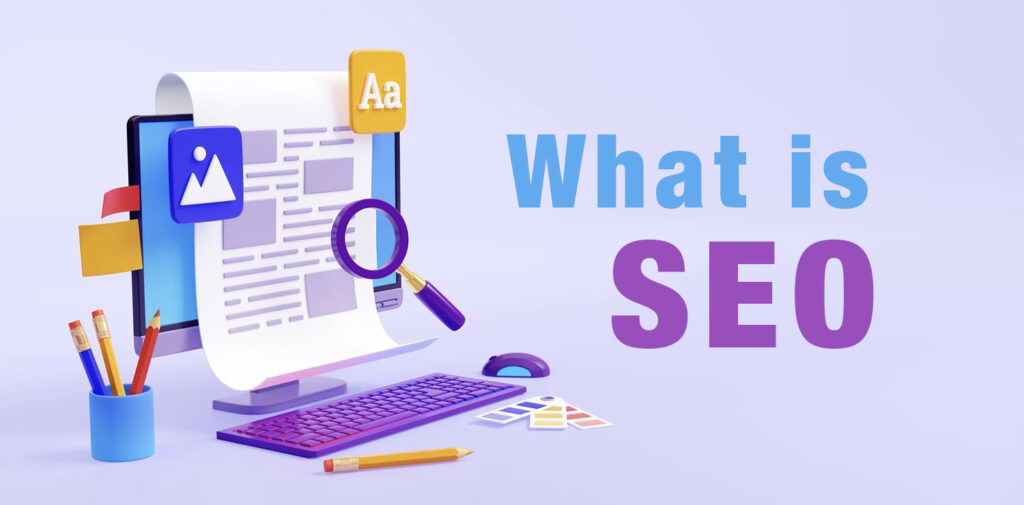Updated: Jun 16, 2023 By: Dessign Team

Search engine optimization, or SEO, is a crucial aspect of a website’s success in the digital world. It comprises a set of practices designed to improve the appearance and positioning of web pages in organic search results, primarily on popular search engines like Google and Microsoft Bing.
By implementing effective SEO strategies, businesses and individuals can increase their website’s visibility, attract more targeted traffic, and ultimately enhance their online presence.
At its core, SEO aims to optimize web pages to make them more easily interpretable and user-friendly for both search engines and their users. This is mainly achieved through relevant content, proper website structure, and strategic use of keywords.
As search engines continuously refine their algorithms, it’s essential to stay informed and adapt one’s SEO techniques to maintain high rankings and remain competitive.
Understanding the fundamentals of SEO is vital for anyone looking to expand their reach in the online sphere. Implementing well-planned strategies helps ensure that a website garners the attention it deserves, ultimately leading to higher visibility, increased organic traffic, and improved business prospects.
Understanding SEO Basics

On-Page SEO
On-Page SEO refers to the practices applied directly to a website to improve its appearance and positioning in organic search results. This primarily involves optimizing content, meta tags, and overall page structure. One essential aspect of on-page SEO is keyword research, where the goal is to identify the most relevant terms and phrases that users search for on search engines like Google.
Using these targeted keywords and phrases in page titles, headings, content, and meta descriptions helps search engines understand the purpose of the web page. When done right, a well-optimized page can potentially rank higher in search results, driving more organic traffic to the website.
Another important aspect of on-page SEO is user experience (UX), which involves making the website easy to navigate and ensuring that it loads quickly. In addition, the site must be mobile-friendly since most searches now happen on mobile devices. By focusing on UX, a website can not only increase its ranking but also provide a more positive experience for users.
Off-Page SEO
Off-Page SEO, on the other hand, revolves around practices implemented outside the website to improve its visibility and ranking on search engines. The most significant aspect of off-page SEO is building high-quality inbound links from authoritative sources, also known as link building. These links help indicate to search engines that the content on the linked website is valuable and reliable.
Additionally, social media sharing, guest blogging, and online directories are other ways to increase a website’s visibility and traffic. By engaging in off-page SEO strategies, a website can improve its overall reputation and standing in the eyes of search engines, further pushing it up the organic search rankings.
In summary, the basics of SEO are founded on two main categories: on-page and off-page optimization. By combining these strategies and following best practices, a website can improve its performance on search engines, attract organic traffic, and ultimately enhance its online presence.
Importance of Keywords

Keyword Research
Keyword research is a crucial aspect of SEO, as it helps identify the terms and phrases potential customers are using in search engines to find products or services.
By targeting these keywords, a website can optimize its content to attract a higher number of visitors and potential customers. It’s essential to understand the search intent behind the keywords to ensure that the content offered meets users’ expectations and provides value.
There are various techniques and tools available for conducting keyword research, such as Google Keyword Planner, Moz, and Ahrefs. These tools help identify the most searched and relevant keywords for your target audience so you can shape your content accordingly.
Long-Tail Keywords
Long-tail keywords are longer and more specific phrases that often have lower search volume but are less competitive, making them easier to rank for compared to short-tail keywords. By targeting long-tail keywords, businesses have a higher chance of driving niche audiences to their website and converting them into customers. These keywords typically cater to a specific search intent, as they reflect a user’s precise query when looking for a product or service.
Incorporating long-tail keywords into your website’s content allows you to better match the needs and interests of potential visitors. Additionally, the increased specificity provided by long-tail keywords often leads to higher conversion rates, as the site’s content is more aligned with the user’s search.
In conclusion, keywords play a vital role in SEO strategies, helping businesses attract the right target audience to their websites. Conducting proper keyword research and focusing on long-tail keywords can provide a competitive advantage in driving high-quality, relevant traffic, ultimately affecting a site’s visibility and conversion rates.
Search Engines and Algorithms

Search engines and algorithms play a crucial role in search engine optimization (SEO), as they are responsible for determining the rank and visibility of websites in search results. The primary aim of SEO is to align a website’s content and structure with the best practices of popular search engines like Google, Bing, YouTube, and Amazon. In this section, we will briefly discuss the different algorithms used by these platforms and how they impact the search engine results pages (SERPs).
Google is the most popular search engine, and its algorithm is continually evolving to provide users with the most relevant and high-quality results. The algorithm crawls and indexes websites by analyzing both the content and technical aspects, such as site architecture, loading speed, and mobile-friendliness. Google’s search features, such as featured snippets, knowledge graphs, and local packs, are designed to provide users with the most relevant information promptly.
Bing
Microsoft Bing is another leading search engine that uses a slightly different algorithm to rank websites. In addition to analyzing on-page content, Bing places a strong emphasis on social signals and backlinks to determine a site’s relevance and authority. Bing’s search features, such as image carousels and video previews, also contribute to enhancing the user experience.
YouTube
As the largest video-sharing platform, YouTube utilizes a specialized algorithm to rank videos based on various factors, including view count, watch time, and user engagement. It plays a significant role in digital marketing efforts for many businesses, as video content becomes increasingly popular amongst users. YouTube’s algorithm prioritizes the relevance and quality of videos to enhance user satisfaction and encourage content creators to produce valuable content.
Amazon
Amazon, the world’s largest online marketplace, employs a unique algorithm called A9 to rank and display products in search results. The algorithm takes multiple factors into account, such as product relevance, price, sales history, and customer reviews, to determine the best product listings for a specific search query. Understanding Amazon’s search algorithm is essential for sellers looking to optimize their product listings and successfully navigate the competitive world of eCommerce.
Each search engine operates using its unique algorithm and requires a tailored approach for website optimization. By understanding and adapting to these algorithms, digital marketers can improve a website’s visibility and performance in organic search results.
Technical SEO
Technical SEO is a crucial aspect of search engine optimization that aims to make websites more accessible, crawlable, and indexable for search engines such as Google and Bing. It ensures that your website meets the technical requirements of modern search engines, allowing them to easily find, understand, and rank your content in search results. There are several important elements of technical SEO that webmasters should focus on, including site architecture, crawling and indexing, site speed and performance, and mobile responsiveness.
Site Architecture
Site architecture refers to the structure and organization of your website’s pages and content. A well-designed site architecture makes it easier for both users and search engines to navigate and understand your website. Key components of a well-designed site architecture include:
- Logical and intuitive navigation
- Clear and descriptive URLs
- Effective use of headings and subheadings
- Proper use of HTML tags and metadata
Using techniques such as schema markup can also help search engines understand your content better and improve your website’s visibility in search results.
Crawling and Indexing
Crawling and indexing are essential processes for search engines like Google and Bing to discover, understand, and rank your web pages. Crawlers or bots, sometimes referred to as spiders, are automated programs used by search engines to visit and index your website’s pages.
To ensure effective crawling and indexing, webmasters should:
- Create and submit XML sitemaps to search engines via tools such as Bing Webmaster Tools
- Control access to specific pages or entire sections using robots.txt
- Use canonical tags to avoid duplicate content issues
Site Speed and Performance
A website’s speed and overall performance play a significant role in both user experience and search engine rankings. Slow-loading pages can lead to higher bounce rates, lower engagement, and a decrease in search engine visibility. To improve your site’s speed and performance, consider:
- Optimizing images and other media
- Implementing server and browser caching
- Using a content delivery network (CDN)
- Minimizing HTTP requests
- Compressing and minifying CSS, JavaScript, and HTML files
Mobile Responsiveness

Mobile responsiveness is the ability of a website to adapt its layout and design to different screen sizes and devices, such as smartphones and tablets. With more people using mobile devices for browsing the internet, search engines like Google place a high importance on mobile responsiveness when determining search rankings.
To ensure your website is mobile-responsive, follow technical best practices like:
- Implementing responsive web design
- Testing your site on multiple devices and browsers
- Using readable, appropriately-sized fonts
- Avoiding overly complex navigation or design elements
By addressing these aspects of technical SEO, webmasters can significantly improve their website’s visibility and rankings on search engines, ultimately leading to increased traffic and better user engagement.
Content Creation and Optimization
High-Quality Content
Creating and optimizing high-quality content is an essential aspect of SEO. High-quality content refers to online material that provides value to the reader, is well-researched, and demonstrates expertise in the subject matter. Examples of high-quality content include informative articles, how-to guides, and engaging videos. When crafting content, focus on being confident, knowledgeable, neutral, and clear to make it easily digestible and appealing to the target audience.
To optimize high-quality content, consider the following tips:
- Use relevant keywords: Identify and incorporate the primary and secondary keywords related to the topic. This helps search engines understand your content’s context and increases its chances of ranking higher on SERPs.
- Create engaging headlines: Compelling headlines attract readers and can increase your click-through rate.
- Make your content shareable: Encourage social sharing through social media buttons or easy-to-share links.
Optimizing Images
Images play a crucial role in enhancing the appeal of your content and can help with search engine rankings if optimized correctly. To optimize images, consider these best practices:
- Use descriptive file names: Name your images with relevant keywords to help search engines understand the content of the image.
- Compress images: Large image files can slow down your page load times, negatively impacting SEO. Compress images to reduce their size without affecting the visual quality.
- Use descriptive alt tags: Adding alt tags with accurate descriptions and relevant keywords helps search engines understand the image’s context and increases its likelihood of appearing in image searches.
Optimizing Videos
Videos are an engaging form of online content that can improve audience retention and conversion rates. To optimize videos for SEO, follow these guidelines:
- Include relevant keywords in the video title and description: This helps search engines understand the video’s topic and increases its chances of ranking higher on SERPs.
- Use video schema markup: Implementing schema markup helps search engines better understand your video content and can result in rich snippets in SERPs.
- Create engaging thumbnails: An eye-catching thumbnail increases the likelihood of users clicking on the video and improves click-through rates.
By focusing on creating high-quality content and optimizing images and videos, you can significantly improve your website’s SEO performance.
Building Trust and Authority

Link Building
Link building is an essential part of building trust and authority in the world of SEO. By acquiring high-quality backlinks from reputable websites, you can demonstrate your website’s credibility and relevance to search engines. This helps improve your website’s visibility in SERPs and drives organic traffic to your site.
To build a strong link profile, focus on creating valuable and shareable content, securing guest blogging opportunities, and building relationships with influencers in your industry.
Domain and Page Authority
Domain Authority (DA) and Page Authority (PA) are crucial metrics for evaluating the trust and authority of a website. Higher values for these metrics generally indicate a stronger online presence and better performance in search engine rankings.
DA measures the overall authority of a domain, while PA considers the authority of individual web pages. You can improve your website’s DA and PA by consistently producing high-quality content, maintaining a solid link profile, and ensuring that your technical SEO is up to par.
Efforts to increase trust, authority, and expertise are crucial for achieving better visibility in search results and driving organic traffic. By focusing on link building and optimizing your domain and page authority, you can establish a strong online presence that will help your website rank higher in SERPs.
User Experience and Engagement
User experience (UX) plays a crucial role in SEO, as it affects how users interact with a website or app and ultimately influences their satisfaction level. A well-designed UX can lead to a more enjoyable user experience, with features that are visually appealing, easy to navigate, and efficient in fulfilling user needs.
By focusing on UX optimization, businesses can create a more welcoming online environment for clients that visit their websites and engage with their content.
User behavior is closely linked to UX, and understanding this connection is essential for SEO success. When users encounter a website with a positive experience, they are more likely to stay longer, browse through multiple pages, and potentially convert by making a purchase or signing up for a service. This can lead to better visibility in search engines, as sites with higher engagement rates are often valued more highly by algorithms.
To improve user experience and engagement, it is important to focus on clear and easy-to-understand content. Breaking text into digestible paragraphs, using bullet points, and employing various formatting options such as bold text and tables can help present information efficiently, making it easier for users to find what they are looking for.
Attracting and retaining clients requires a strong understanding of user experience and the factors that contribute to user satisfaction. By optimizing UX, businesses can increase their website’s visibility in search engines, leading to more organic traffic and, eventually, higher conversion rates. A website that has engaging content, a visually appealing design, and is user-friendly can significantly boost its SEO performance.
In conclusion, focusing on user experience and engagement is a critical element in SEO strategy. By providing a seamless online environment for users, businesses can improve their website’s visibility and, ultimately, increase the likelihood of driving conversions.
Black Hat vs White Hat SEO
In the world of search engine optimization (SEO), there are two main approaches: Black Hat SEO and White Hat SEO. These methods have their own techniques and strategies which can impact the performance of websites in search engine results. It is important for website owners and SEO professionals to understand the difference between these approaches and the potential consequences of using each one.
Black Hat Techniques
Black Hat SEO involves using practices that violate search engines’ guidelines and terms of service, often with the aim of artificially boosting a website’s search engine rankings. Some common black hat techniques include:
- Keyword stuffing: Overusing keywords in the website’s content or meta tags without adding value or context to improve rankings for specific search terms.
- Cloaking: Presenting different content or URLs to search engines and users, attempting to deceive search engines to display the webpage for unrelated queries.
These techniques might provide short-term gains in search rankings; however, they can result in penalties or even removal from search engine indexes when discovered. The focus of black hat tactics is on manipulating search engines rather than providing value to users.
White Hat Strategies
White Hat SEO, on the other hand, follows the search engine guidelines and aims to create a long-term, sustainable online presence. These ethical strategies focus on providing high-quality content and an optimal user experience. Some common white hat SEO techniques include:
- Keyword research: Identifying relevant and valuable keywords that users are searching for, and including them in a natural, meaningful way in the website’s content.
- Optimizing content: Writing informative and engaging content that appeals to the target audience, while ensuring it follows proper formatting and includes appropriate headings, subheadings, and images.
- Technical optimization: Improving the website’s internal structure, page load speeds, mobile responsiveness, and other technical aspects to enhance the user experience.
White hat strategies prioritize the needs of users, ensuring that a website offers genuine value and adheres to search engines’ rules. This approach reduces the risk of penalties and promotes long-term growth in search engine rankings.
Measuring and Improving SEO
Analyzing Traffic and Rankings
Measuring and improving SEO is critical for any website to achieve better visibility and higher organic results. Analyzing traffic and rankings helps identify the success of a website’s current SEO efforts and areas that require improvement. To monitor a website’s performance, it is essential to extract data using various research tools such as Moz Pro.
One of the primary goals of SEO is to increase organic search traffic. Analyzing organic results allows website owners to understand how search engine crawlers perceive the site’s content relevance and quality. By monitoring organic results, improvements can be made to on-page elements, such as titles, meta descriptions, and headings.
Examining backlinks, or links from other websites, is a vital aspect of SEO, as they contribute to a site’s credibility and authority. A strong backlink profile can lead to better search rankings, with a focus on high-quality websites linking back to the site.
SEO Tools and Resources
Several SEO tools and resources are available to help analyze and improve website performance. Moz Pro offers a suite of research tools, allowing users to track keyword rankings, monitor backlinks, and discover potential technical issues.
Another essential SEO aspect is the optimization of featured snippets, which are prominent search results displayed above the organic listings. Featured snippets enhance a site’s visibility and increase click-through rates. Tools such as Moz Pro can also help identify opportunities for achieving featured snippets on targeted keywords.
Finally, keeping in mind the complexities of SEO, website owners must stay updated with the latest trends and best practices. Using available resources such as blogs, articles, and case studies can significantly improve a website’s SEO strategy and performance in search engines.
SEO Strategies for Different Channels
When planning an SEO strategy, it’s important to adapt the approach based on the channel and the specific needs of the industry, audience, and customers. In this section, we will cover various SEO strategies for different channels such as Local SEO, E-Commerce SEO, YouTube SEO, and Amazon SEO.
Local SEO
Local SEO is the optimization strategy that focuses on improving the visibility and presence of local businesses in search results for keywords related to their services and products. These keywords may include specific geographic locations or phrases associated with local searches. To cater effectively to the local audience, the following tactics can be used:
- Optimize your business’s Google My Business profile and regularly update the information
- Collect and manage online reviews and testimonials
- Use structured data markup (schema) to provide search engines with information about your business
- Invest in localized content development, including blog posts, city-specific landing pages, and localized keyword research
E-Commerce SEO
E-Commerce SEO involves optimizing online stores and product pages to rank higher in organic search results, which can ultimately lead to increased sales. To achieve success, the following strategies can be employed:
- Perform thorough keyword research to identify high-converting customer search terms
- Optimize product titles, descriptions, and URLs with relevant keywords
- Enhance website speed, user experience, and mobile-friendliness
- Develop and implement a content strategy to target long-tail keywords and attract potential customers through informative or entertaining content
YouTube SEO
YouTube SEO focuses on optimizing video content for better visibility on YouTube’s search engine, which is the second largest behind Google Search. To rank high in search results and attract a wider audience, these practices should be followed:
- Conduct keyword research to identify terms that resonate with the audience and lead to increased views
- Optimize video titles, descriptions, and tags with targeted keywords
- Design eye-catching and relevant custom video thumbnails
- Encourage audience engagement through likes, comments, and shares to increase video authority and visibility
Amazon SEO
Amazon SEO aims to optimize product listings to rank higher in Amazon’s marketplace search results, leading to more sales and customer satisfaction. The following strategies are effective in achieving a higher ranking:
- Carry out keyword research to discover search terms that resonate with the target audience and drive organic traffic
- Enhance product titles, descriptions, bullet points, and images to accurately portray the product
- Encourage customers to leave positive reviews and promptly address any negative feedback
- Utilize advertising options such as Amazon PPC to boost visibility and sales, while continually monitoring performance and optimizing ROI
By employing these tailored SEO strategies for different channels, businesses can ensure they reach their intended audience and maximize the potential for success in their respective sectors.
Frequently Asked Questions
How does SEO improve website visibility?
SEO, or search engine optimization, is the process of optimizing a website to perform well in organic search results, making it more visible to users. By implementing various on-page and off-page optimization techniques, such as keyword research and quality content creation, a website can improve its rankings on search engines like Google. As a result, a higher-ranked website is more likely to attract organic traffic, increasing its visibility and user engagement.
What role does SEO play in digital marketing?
In the realm of digital marketing, SEO is an essential strategy to improve a website’s visibility and drive organic traffic. It is a cost-effective approach that helps businesses of all sizes reach and engage their target audience. By investing in SEO, companies can increase brand awareness and achieve higher returns on investment (ROI) from their online marketing campaigns.
What tools are essential for effective SEO?
Effective SEO requires a collection of tools to analyze and optimize various aspects of a website. These tools can range from keyword research and analytics to backlink analysis and technical auditing. Some well-known SEO tools include Google Analytics, Google Search Console, SEMrush, Moz, and Ahrefs. These tools help marketers identify opportunities for improvement and measure the success of their SEO campaigns.
What are the various types of SEO techniques?
SEO techniques can be classified into three categories: on-page, off-page, and technical SEO. On-page SEO involves optimizing the content and HTML source code of a website, including meta tags, headings, and URL structure.
Off-page SEO focuses on creating high-quality backlinks pointing to a website, social media engagement, and other factors that signal a website’s authority and relevance. Technical SEO addresses issues like mobile-friendliness, site speed, and crawlability to ensure search engines can discover and index a website’s content effectively.
How can a business benefit from SEO?
Businesses can reap numerous benefits from implementing SEO strategies. These benefits include increased visibility and organic traffic, enhanced user experience, higher customer trust and credibility, improved local search presence, and ultimately, increased sales and ROI. In today’s competitive online marketplace, a solid SEO strategy is crucial for businesses to stand out from their competitors and attract their target audience.
What are the key aspects of an SEO course?
An SEO course typically covers topics such as keyword research, content creation and optimization, link building, on-page and off-page optimization, technical SEO, and Google Analytics. A comprehensive SEO course should also include hands-on projects and case studies, providing learners with practical experience to apply their newly-acquired skills. Some courses may also help in preparing for industry-recognized certifications or offer mentorship from industry experts.